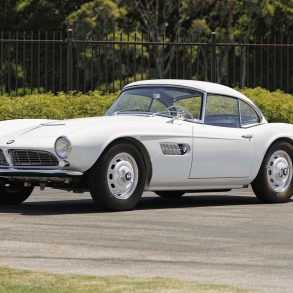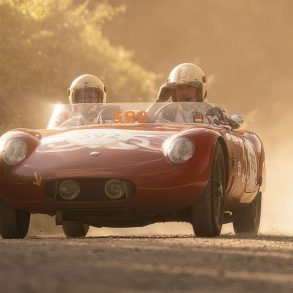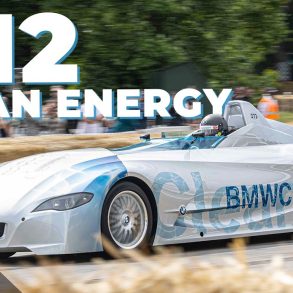
Driving at an average speed of 166.7 km/h, they set a record that would remain unbeaten. The second-placed car, an Alfa Romeo, did not cross the finish line until a quarter of an hour after the victorious BMW 328. (It is worth noting that the 1940 race was called the Grand Prix of Brescia, and held on a 100 km course in the fast plains of Northern Italy that was lapped nine times).
For BMW, this impressive success was to remain the only overall victory in the classic event, as World War II initially put an end not only to the Mille Miglia but also to BMW’s motor racing activities. On its revival in 1947, the Mille Miglia once again led from Brescia to Rome and back, but BMW no longer sent works teams to Italy. Despite no factory support, private competitors continued with the BMW 328 and other models such as the BMW Isetta and BMW 507.
In honor of their Mille Miglia history, each year BMW Classic sends a range of vehicles from its collection to compete in the Mille Miglia Storica, in addition to the private teams that also race in the 1,000-mile event.
BMW Competing in the 2009 Mille Miglia Storica
BMW 328 Berlin-Rome Touring Roadster
In the hope of competing in the Berlin-Rome race scheduled for 1941, Germany’s National Sports Authority had three existing BMW Roadsters fitted with more advanced aerodynamic roadster bodies by Carrozzeria Touring of Milan. What ultimately emerged were racing cars that boasted an outstandingly good drag coefficient for the time. The events of the Second World War, however, put an end to any further motor racing events with German involvement.
Year of construction: 1937 chassis, 1941 body
Engine: 1971 cc, six-cylinder in-line, 136 bhp at 6000 rpm
Brakes: Alfin drums, vented brake back plates
Weight: 780 kg (1,716 lbs)
Maximum speed: 200 km/h (125 mph)
BMW 328 Roadster
The 328 Roadster, developed in 1935/36, is one of the legends of automobile history. Although only modest facilities were available, the result was a sports car of most attractive appearance that soon dominated the two-litre class. Modified competition versions won their classes at Le Mans and in the Mille Miglia. Of the 464 cars that were built, 403 had the standard roadster body, the remaining chassis being used for racing versions or special bodywork ordered by customers.
Years of construction: 1936 – 1940
Engine: 1971 cc, six-cylinder in-line, 80 bhp at 4500 rpm
Brakes: Hydraulic drum brakes
Weight: 780 kg (1,716 lbs)
Maximum speed: 155 km/h (96 mph)
BMW 328 Touring Coupe
The company Touring in Milan built a particularly light-weight “superleggera” coupé body on the BMW 328 chassis for use in fast long-distance races. The improved aerodynamics were intended to achieve much higher speeds. The car was first used in June 1939 in the 24-hour race at Le Mans. Max Prinz zu Schaumburg-Lippe and Hans Wencher won the 2-litre sports-car class in a new record time and finished 5th overall. In April 1940, the car driven by Fritz Huschke von Hanstein and Walter Bäumer won a commanding overall victory in the Mille Miglia.
Year of construction: 1939
Engine: 1971 cc, six-cylinder in-line, 136 bhp at 6000 rpm
Brakes: Alfin drums, vented brake, back plates
Weight: 780 kg (1,716 lbs)
Maximum speed: 220 km/h (137 mph)
BMW 328 Mille Miglia Roadster
For lack of time, two of the three BMW 328 Roadster models scheduled to compete in the 1st Gran Premio Brescia delle Mille Miglia of 1940 had their bodywork built not in Munich, but by coachbuilders Touring of Milan on the basis of BMW designs. Like the BMW 328 Coupé, this aerodynamically advanced, ultra-lightweight body consisted of a tubular space frame with an aluminium skin. The team behind the wheel of this car comprised Willy Briem and Uli Richter, who propelled it to an outstanding fifth place overall in the 1940 Mille Miglia and thus played a key role in securing the team prize for BMW.
Year of construction: 1940
Engine: 1971 cc, six-cylinder in-line, 130 bhp at 5750 rpm
Brakes: Alfin drums, vented brake, back plates
Weight: 700 kg (1,540 lbs)
Maximum speed: 200 km/h (125 mph)
BMW 507 Roadster
The BMW 507 roadster was launched at the 1955 Frankfurt Motor Show. BMW had succeeded in creating one of the most beautiful sports cars of all time. The car was based on the technology of the 3.2 litre 502 saloon but with the power output increased to 150 bhp. The 507 was built to a design created by Albrecht Graf Goertz, a colleague of Raymond Loewy. This sports car, available with three different rear-axle transmission ratios and a range of top speeds between 190 and 220 km/h, worked wonders for the image of Bayerische Motoren Werke. Almost all BMW 507s, in many cases bought originally by international celebrities, are still on the road today. Two of them have special bodies.
Years of construction: 1956 – 1959
Engine: 3168 cc, V-8, 150 bhp at 5000 rpm
Brakes: Hydraulic duplex brakes with servo
Weight: 1220 kg (2,684 lbs)
Maximum speed: 205 km/h (127 mph)
BMW Competing in 2009 Mille Miglia Storica Picture Gallery
[Source: BMW]




































Being always interested in prewar BMWs, it’s a treat to revisit the 2009 Mille Miglia Storica. “Rear View” is an excellent addition to SCD Weekly!